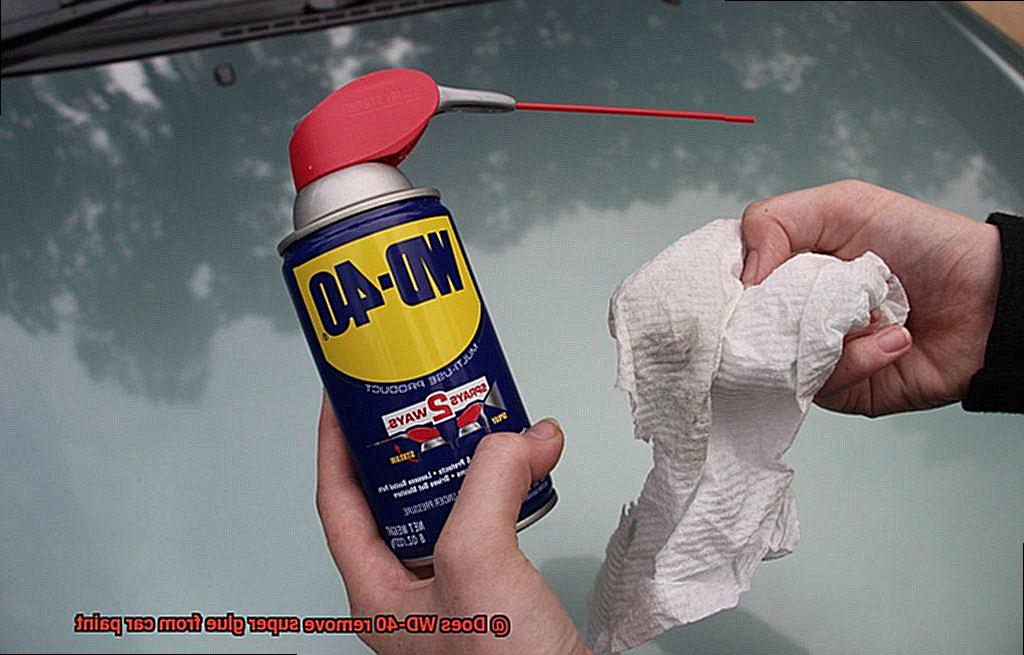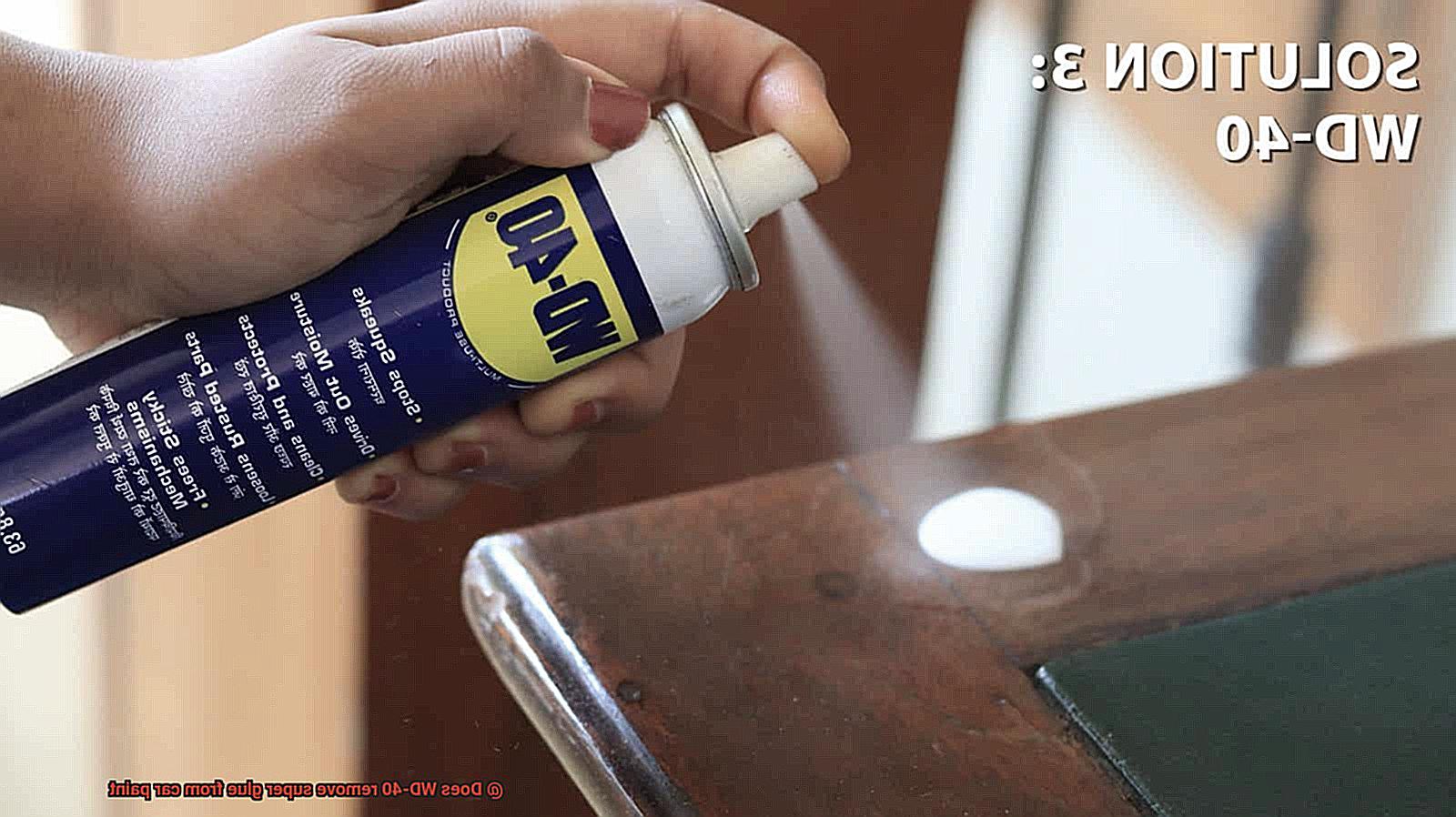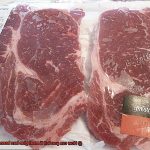Imagine this nightmare scenario: you’re admiring your gleaming ride, reveling in its flawless paint job, when suddenly, your eyes lock onto a stubborn super glue stain mocking your automotive pride. Panic surges through your veins as you frantically search for a solution to this sticky mess. Fear not, my fellow car enthusiasts, for we have a secret weapon in our arsenal – the legendary WD-40.
This jack-of-all-trades lubricant has saved us from countless household conundrums, but can it work its magic on super glue and preserve our precious car paint? Today, we embark on an epic journey into the realm of WD-40 to determine if it’s truly the hero we need or just another myth in the world of automotive remedies.
So, grab your seatbelt and get ready to uncover the truth about this trusty spray – will it be victorious or should we keep it locked away?
What is WD-40?
Contents
- 1 What is WD-40?
- 2 What is Super Glue?
- 3 The Dangers of Super Glue on Car Paint
- 4 Can WD-40 Remove Super Glue from Car Paint?
- 5 How to Use WD-40 for Removing Super Glue from Car Paint
- 6 Considerations When Using WD-40 for Removing Super Glue
- 7 Alternatives to Using WD-40 for Removing Super Glue
- 8 Common Mistakes to Avoid When Removing Super Glue with WD-40
- 9 Conclusion
When faced with a stubborn rusted bolt or sticky residue that won’t budge, one product has stood the test of time as a household staple for over six decades – WD-40. In this article, we will explore the origins, composition, and wide range of uses for this versatile multi-purpose lubricant and solvent.
Origins and Composition:
WD-40, an acronym for “Water Displacement, 40th formula,” was developed in 1953 by a team of chemists led by Norm Larsen. Originally created to prevent corrosion in aerospace equipment, WD-40’s unique blend of petroleum-based oils, solvents, and propellants proved highly effective. It became commercially available in 1958.

The Power of Versatility:
One of WD-40’s greatest strengths lies in its versatility. Its lubricating properties make it ideal for loosening rusted or stuck parts, while its water-displacing abilities create a protective barrier against corrosion. This makes it invaluable for automotive applications, safeguarding exposed metal parts from the damaging effects of moisture.
Beyond the automotive realm, WD-40 has found its way into countless households and workshops due to its ability to solve a wide range of problems. It can remove adhesives, lubricate squeaky hinges, silence noisy door locks, and even clean and protect tools from rust.
Expert Tips for Safe Use:
While WD-40 is a powerful tool, it is important to exercise caution when using it. Always read and follow the instructions on the product label before use. Additionally, it is advisable to test WD-40 on a small, inconspicuous area before applying it to larger surfaces to ensure compatibility and avoid any potential damage.
What is Super Glue?
Super glue, the superhero of adhesives, bursts onto the scene with its incredible bonding powers. Also known as cyanoacrylate adhesive, this fast-acting and formidable glue is a game-changer in the world of bonding. But what exactly is super glue and why is it so popular? Prepare to be amazed as we delve into the secrets of this adhesive hero.
Super glue was initially discovered in the 1940s by Dr. Harry Coover, who was working on developing clear plastic gun sights for World War II. At first, it was seen as impractical due to its tendency to stick to everything it touched. Little did they know, this stickiness was a hidden superpower waiting to be unleashed. By the 1950s, super glue was commercially available and ready to save the day.
What sets super glue apart is its lightning-fast bonding ability. While traditional adhesives take hours or even days to fully cure, super glue dries within seconds or minutes. This means you can fix things in a flash and get back to being a hero.
But wait, there’s more. Super glue isn’t just fast; it’s incredibly strong too. It can bond an impressive array of materials, from plastics and metals to ceramics and glass. Like a trusty sidekick, it effortlessly joins any surface together, creating an unbreakable bond. Whether you’re repairing broken objects or assembling small parts, super glue has got your back.
And its powers don’t stop there. Super glue is also highly versatile. It can withstand extreme temperature changes without losing its bonding strength. So whether you’re battling icy cold or scorching heat, super glue won’t let you down. It’s also resistant to water and many chemicals, making it durable in various environments.
However, like any superhero, super glue does have its limitations. It’s not suitable for flexible materials or surfaces that are constantly in motion. Additionally, certain plastics or low-surface-energy materials may not bond well with super glue. So make sure you choose the right adhesive for your specific needs.
The Dangers of Super Glue on Car Paint
Super glue, the hero of broken objects, can quickly become a villain when it encounters car paint. The risks involved in using super glue on car paint are numerous and potentially disastrous. Let’s explore the dangers lurking in our garages.
First and foremost, the damage caused by super glue on car paint is a significant concern. The chemicals in super glue can react with the paint, resulting in unsightly discoloration, fading, and even peeling. Picture spending hours meticulously polishing and waxing your prized vehicle, only to have it ruined by a tiny accidental spill of super glue. It’s a nightmare no car enthusiast wants to experience.
But that’s not all. Super glue can also create a rough and uneven surface on the paint, leaving it vulnerable to further harm from UV rays and moisture. Your once glossy and seamless paint job may become a magnet for scratches and chips, diminishing its aesthetic appeal and value.
Removing super glue from car paint is no easy feat either. Attempting to scrape or chip off the dried glue could result in scratches and chips, necessitating costly repairs. Even using solvents or chemicals to remove the glue carries risks. These substances may dissolve or weaken the paint, causing permanent damage or color fading.
Different types of car paints may react differently to super glue, so caution is paramount. Avoid using super glue near painted surfaces whenever possible, and if any accidental spills occur, seek professional assistance immediately.

In conclusion, while super glue may be a superhero in many situations, it can quickly transform into a villain when it comes to car paint. Let’s keep our vehicles safe by steering clear of super glue near their precious paint jobs. Remember, prevention is always better than costly repairs.
Can WD-40 Remove Super Glue from Car Paint?
In this captivating blog post, we’ll delve into the world of solvents, adhesives, and car paint to uncover the truth about using WD-40 as a potential solution. Buckle up and get ready for the ride.
The WD-40 Experiment:
As curious DIY enthusiasts, many of us have wondered if WD-40 can come to the rescue and remove super glue from car paint. But before you embark on this daring mission, it’s crucial to proceed with caution. WD-40 is not specifically designed for car paint, and improper use can lead to irreversible damage.
Patch Test:

To test the effectiveness of WD-40, perform a patch test on an inconspicuous area of your car. Grab a soft cloth, apply a small amount of WD-40, and gently rub the affected area. Keep a keen eye out for any changes in the super glue or the car paint. Remember, gentle pressure is key.
The Results:
In some cases, WD-40 may work its magic by softening the super glue, making it easier to peel off or scrape away. However, let’s not get carried away – there’s no guarantee that it will eliminate all traces of super glue. It’s important to be mindful of excessive force that could potentially scratch or damage your car paint.
Professional Help:
If you’re unsure about using WD-40 or if the super glue proves to be a stubborn adversary, don’t hesitate to seek professional assistance. Auto detailing experts or professional car painters possess specialized knowledge and techniques for safely removing super glue from car paint.
Prevention is Key:
Remember, prevention is always better than cure. To avoid accidental spills or drips, take precautions when using super glue near your car. Protect your vehicle with a handy-dandy sheet or plastic wrap to prevent any potential damage.
How to Use WD-40 for Removing Super Glue from Car Paint
The incredible multi-purpose product, WD-40, has got your back. It can work wonders in removing super glue from your car’s shiny exterior. Here’s a step-by-step guide on how to effectively use WD-40 for this purpose:
Test, test, test
Before diving headfirst into the removal process, it’s crucial to conduct a patch test. Apply a small amount of WD-40 on an inconspicuous area of the car paint, and observe for any adverse reactions like discoloration or damage. Safety first.
Spray and wait
Once you’ve confirmed that WD-40 is safe to use, spray a small amount directly onto the super glue-stained area. Let the magic of WD-40 unfold by allowing it to sit for a few minutes. This gives the product ample time to penetrate and loosen the adhesive bond.
Gentle rub

Armed with a soft cloth or sponge, proceed to gently rub the affected area where the super glue is stubbornly clinging on. Exercise caution and avoid scrubbing too vigorously, as this could cause harm to your car’s precious paintwork. Begin from the outer edges of the glued area, gradually working your way towards the center.
Scrape if needed
In case the super glue remains unyielding, fear not. Equip yourself with a plastic scraper or even an old credit card. With utmost care and patience, meticulously scrape off any lingering adhesive remnants. Take your time to ensure you don’t inadvertently scratch or mar the car’s paint.
Clean up
After triumphantly removing all traces of super glue, it’s time to give your car some tender loving care. Grab a clean cloth dampened with soapy water and wipe down the treated area to eliminate any residue left behind by the WD-40. Rinse with water, ensuring a thorough cleanse, and then diligently dry the surface.

Remember, WD-40 may not work effectively on all types of super glue, especially if it has fully dried and hardened. In such circumstances, it’s wise to seek professional assistance or explore alternative specialized adhesive removers.
Considerations When Using WD-40 for Removing Super Glue
Accidents happen, and sometimes that means getting super glue on your car paint. But fear not. The superhero of household products, WD-40, is here to save the day. With a few simple considerations, you can remove that pesky super glue without damaging your car’s beautiful finish. Let’s explore the world of WD-40 and uncover the secrets to successfully removing super glue from car paint.
Consideration #1: Patch Test
Before unleashing the powers of WD-40 on your car paint, it’s crucial to conduct a patch test. Apply a small amount of WD-40 on an inconspicuous area of your car to ensure it won’t cause any damage or discoloration. Better safe than sorry.
Consideration #2: Non-Porous Surfaces

WD-40 works wonders on non-porous surfaces like car paint. However, if your car’s paint has any cracks or chips, it may not be suitable for WD-40 application. Ensure that the surface is intact before proceeding.
Consideration #3: Application and Waiting
Once you’ve confirmed compatibility, spray WD-40 directly onto the super glue stain. Let it sit for a few minutes, allowing the magic solution to penetrate and loosen the glue’s bond with the car paint.
Consideration #4: Gentle Scrubbing
Grab a soft cloth or sponge and gently scrub the affected area starting from the edges and working towards the center. Avoid using abrasive materials or applying excessive force, as this may damage the car paint. Patience is key.
Consideration #5: Thorough Rinsing

After successfully removing the super glue, rinse the area thoroughly with water. This step is crucial to remove any residue and prevent potential damage to the car paint. Don’t skip this.
Consideration #6: Multiple Applications
In some cases, stubborn super glue may require multiple applications of WD-40. Be patient and let the solution work its magic. Forcing the glue off may result in unwanted damage to your car paint, so take your time.
Consideration #7: Wash and Wax
You’ve triumphed over the super glue. To give your car a well-deserved treat, wash and wax the affected area. This will restore its shine and provide protection against future mishaps.
Alternatives to Using WD-40 for Removing Super Glue
We’ve all experienced the frustration of super glue stains on our car paint. But fear not. While WD-40 is a popular choice for removing super glue, there are several alternatives that can save the day without causing damage to your car’s finish. In this post, we’ll explore some effective and safe alternatives to WD-40 for removing super glue from car paint.
So, let’s dive in and discover the heroes that can restore your car’s pristine appearance.
Acetone: The Nail Polish Remover Trick
Acetone, found in nail polish removers, is a powerful solvent that breaks down super glue bonds. Apply a small amount on a cotton swab or cloth and gently rub the affected area. However, be cautious as acetone can damage car paint, so use it sparingly and with care.
Rubbing Alcohol: The Trusty Sidekick
Rubbing alcohol is another effective alternative. It dissolves super glue bonds without harming car paint. Apply it to the affected area using a cloth or cotton swab. To be safe, test it on a small, inconspicuous spot first.
Vinegar: The Natural Hero
Harness vinegar’s acidity to dissolve super glue. Soak a cloth or sponge in vinegar and apply it to the stained area. Let it sit for a few minutes before gently rubbing or scraping off the glue.

Lemon Juice: The Zesty Ally

Lemon juice’s citric acid content makes it effective in breaking down super glue bonds. Squeeze fresh lemon juice onto a cloth or sponge and apply it to the affected area. After a few minutes, gently rub or scrape off the glue.
Warm Soapy Water: The Gentle Savior
When all else fails, turn to warm soapy water and a soft cloth. The soap helps loosen the glue, making it easier to remove without harming your car’s paint. It may require some elbow grease, but the glue will eventually come off.

Remember, regardless of the method you choose, work in small sections and avoid excessive scrubbing or scraping to prevent damage to your car’s paint. After removing the glue, wash and wax the area to restore shine and protect the paint.
Common Mistakes to Avoid When Removing Super Glue with WD-40
Imagine the frustration of discovering a super glue stain on your car’s paint. Luckily, WD-40 can come to the rescue. However, it’s crucial to know the common mistakes to avoid when using WD-40 for removing super glue. In this guide, we will explore the do’s and don’ts of using WD-40 to effectively remove super glue stains without causing any damage.

Gentle is key:
Excessive force may seem tempting when dealing with stubborn super glue stains, but proceed with caution. Applying too much pressure or scraping aggressively can harm your car’s paint. Remember to exercise patience and be gentle when using WD-40.
Allow time for the magic:
Super glue is known for its tenacity, so give WD-40 some time to work its magic. Spray the affected area and allow the solvent to penetrate and dissolve the adhesive effectively by letting it sit for a few minutes.
The right tools for the job:
Using improper tools or materials can lead to disaster when removing super glue. Opt for soft cloths or microfiber towels to gently wipe away the dissolved glue. Avoid abrasive materials or rough sponges that could scratch your car’s paint.
Protect, protect, protect:
While WD-40 is a superhero against super glue, it can cause damage to other surfaces like plastic or rubber trims. Before spraying WD-40, cover these areas with masking tape or plastic wrap to prevent accidental damage.
Finish strong:
After successfully removing the super glue, don’t forget to properly clean and dry the area. Use mild soap and water to clean the surface, followed by a thorough rinse and drying with a clean cloth. This ensures no residue or streaks are left behind.
nv1v2ZGdPX4″ >
Conclusion
In conclusion, WD-40 can indeed be an effective solution for removing super glue from car paint. Its powerful formula penetrates the adhesive bond, loosening its grip on the surface. With a few simple steps, you can restore your car’s paint to its pristine condition.
Using WD-40 is like having a secret weapon in your arsenal against stubborn super glue stains. This versatile product not only removes grease and grime but also tackles tough adhesives with ease. Say goodbye to unsightly glue marks on your car’s exterior.
But let’s not forget about the importance of caution when using WD-40 on car paint. While it can effectively dissolve super glue, it’s crucial to test it on a small, inconspicuous area first to ensure it doesn’t damage the paintwork. Always follow the instructions provided by the manufacturer and handle with care.






